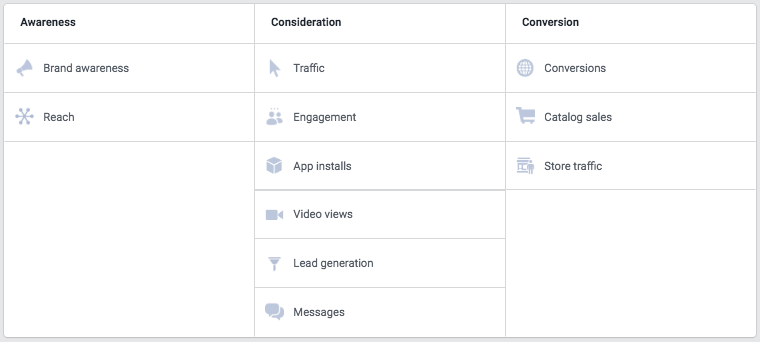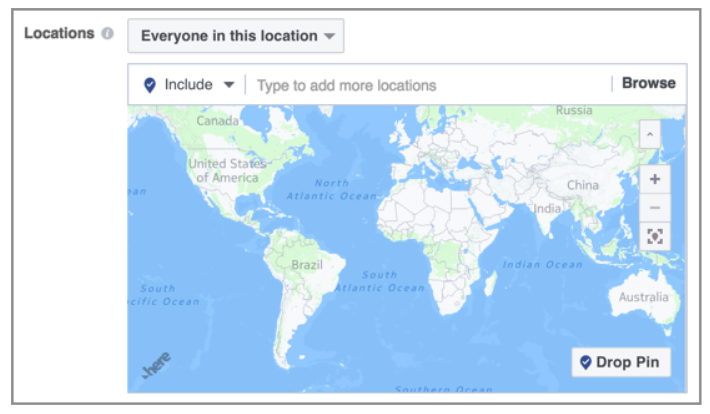If you advertise on Facebook, then you know it’s a great place to reach your ideal customer. You know all about the targeting, the creative and all the amazing placements. You also know that scaling your business on Facebook can be hard!
Knowing how quickly you can scale and still maintain a strong return on ad spend can be challenging for any business. Maybe you are interested in growing your audience beyond what you have today and just don’t know how. Or maybe you’ve increased your ad spend to find your results start to drop.
Well great news. We’ve put together some of our suggestions to help guide you and your campaigns to successful scale!
1. Defining Your Objective
First things first. Know what you want; understanding your objective is key. Define your goals using Facebook objectives to establish what success looks like to you and for your business.

It’s likely that as your business grows, your goals will change. Maybe you start at the top of the funnel, making people aware of your business finding potential customers through different audiences. Later, you may want people to start making purchases, or attend your event or maybe even download your app.
Defining your Facebook objective(s) and ensuring they are aligned with your business goals is the first step to effectively scaling your campaigns.
2. Get to Know Your Facebook Audience
Understanding your customers behavior and how they interact with the platform is also crucial to your success. Using Facebook’s Audience Insights tool can help!
Insights will help you tailor your posts to ensure you’re providing the right content with the followers you already have.

Audience Insights can also help you expand your reach to an even larger group of potential customers by analyzing demographics, page likes, location and activity of your target audience.
For example, say you are advertising to those who love Yoga. Through Audience Insights, the data shows these same users are also lovers of home décor. Not only can you scale through specific audiences geared towards home décor but you can also ensure that the content you are promoting is aimed towards home décor lovers that are active in Yoga. Namaste
3. Test a Variety of Targeting
Testing is key. Rather than immediately increasing your bids and budget, consider the size and type of the audience you’re targeting. Going from small, tightly defined audiences to a variety of broader audiences boosts efficiency, maintaining performance and also lets the Facebook pixel find you more customers.
Regardless of your budget, allow yourself plenty of time to test the waters with a lower daily budget (or low average daily if you’re using a lifetime budget.) Rather than going from 0 to 100 on spend, develop a testing plan and stick with it. This will help you maintain your spend from outpacing the amount of conversions and thus generating a high cost per acquisition (CPA) from the get-go. It also makes it easier to improve performance as you identify what’s working and increase spend accordingly.
Recommended Audiences to start with:
- Customer lists
- Website custom audiences
- Lookalike of customer lists and website customer audiences
- Interests, behaviors and demographics
Pro tip: Don’t forget about your exclusion targeting! When using first-party data (such as website custom audiences) suppress those who purchase from other channels and have a consistence cadence of refreshing these lists.
4. Building Your Funnel
We get it, day to day performance is important. But what about the long game? If your marketing program is measured by return on ad spend (ROAS), consider looking beyond the immediate return and focus on growing your customer’s lifetime value.
This requires investing in the program; advertisers often breakeven or even incur a minor deficit on the original media investment in exchange for a longer term pay off. By investing more into branding and mid-funnel initiatives, you’re better able to stay top of mind amongst prospecting, and increase their propensity to convert down the line.
Focusing on higher-funnel activity allows you to build your first party CRMs lists. This will ensure a healthy pipeline of intent-driven customers to remarket to whenever appropriate.
Another benefit of investing into mid-funnel initiatives is that it helps build a larger pool of users to retarget via Website Custom Audiences (WCAs) or Dynamic Product Ads (DPA) tactics. Growing these audiences is an important step to scaling your Facebook ad spend.
Pro tip: Another way to scale prospecting is by using Dynamic Ads for Broad Audiences. (It relies on Facebook’s algorithm to find prospects based on their intent signal generated across the web, rather than just the advertiser’s site).
5. Test Worldwide Targeting
Did you know that Facebook has a targeting option that lets you target the entire world?

By selecting multiple countries and exclude any country you may not be able to ship to or work within, Facebook will deliver ads to the countries with the best cost per action (CPA), giving you invaluable insight into what works and what doesn’t.
Pro tip: Refine your worldwide audience by creating a Lookalike audience of your current customers or website visitors.
6. Expand Using Lookalike Audience
A lookalike audience is a group of people that Facebook considers similar to your own customers in varying degrees, whether by demographics, incomes, online purchasing behavior, etc.
With Value-Based lookalikes you’re able to target Facebook users based on their similarity to your highest value customers.
Standard lookalike audiences are similar to value-based ones, except instead of targeting users based off an attributable dollar value, they let you target people similar to those who like your page or have taken specific actions you’ve assigned to a CRM list. For example, people who signed up as leads through a separate email campaign you ran.
Audience size ranges from 1% to 10% of the combined population of your selected locations. A 1% lookalike consists of the people most similar to your lookalike source, while increasing the percentage up to 10% creates a bigger, and broader audience.
Pro tip: Leveraging pixel data allows you to target people based off real actions they’ve taken, and not just assumptions about your customers.
7. Campaign Budget Optimization
You likely have core targeting that drives a large volume of conversions, but you may be missing converters that live outside of your retargeting or niche interest groups. One way to reach these users and scale conversion volume is by introducing a variety of demographically-related interest groups and leveraging Facebook’s Campaign Budget optimization (CBO) tool.
For example, if I am promoting my 10-step skin care line, I may test audiences related to footwear, college students, k-pop, and fitness. No, these audiences aren’t directly related to skin care, but they may reach users in my 18-24 female demographic that aren’t covered in my core targeting. The real power comes with using CBO – it allows Facebook to find the low-hanging-fruit converters in these non-core audiences without over-scaling to a pre-determined budget.
Pro tip: Use AdParlor automation engine to seamlessly pause test audiences when they don’t meet your KPI goals and rotate in new test audiences. No more micro-managing bids and budgets.
8. Use Automatic Placements
Facebook’s platform is massive. Don’t be afraid to test all of the available placements outside of the Newsfeed. There is a lot of scale (and potentially strong performance) to be had with running across Facebook, Instagram, Audience Network, and Messenger Ads.
Using Automatic placements enables Facebook to get the best results available, by choosing results from the widest range possible.
Pro tip: If you used automatic placements and decide to duplicate a campaign, any new placements will automatically become available for your duplicated ad.
9. One Size Does Not Fit All
One thing to keep in mind while preparing for any upcoming campaign is that creative should not be approached as a “one size fits all” piece. Within Facebook, there are many types of ad units to consider. In order to achieve the greatest reach and scale, your teams need to ensure that all avenues have been considered.
Many times, Facebook will auto select creative for Instagram or Facebook stories, however, it has been proven that creative that looks native to the environment (minimal to no text, animated and imagery focused) will outperform that of the pre-selected creative in the platform.
Because of this, it is imperative that your creative teams consider all potential placements for maximum reach and better performance overall.
Pro tip: If you are using a video or stories, use a voice-over or music as creative tools to enhance the message of your brand or product.
10. Personalize Your Creative
Don’t tell your audience to buy something, SHOW them! Incorporate key micro moments that the target audience can relate to and provide a use case to the product/service. Analyze content that has been successful for organic posts and repurpose them for paid campaigns.
People want to see content that is personalized and relatable to them. In fact, 79% of companies who incorporated a personalization strategy exceed their revenue goals.
Pro tip: Using tools such as Creative Blueprints enables brands and advertisers to quickly create a variety of ads and target to different audiences.
11. Trust the Process
Facebook’s algorithms are smart and typically work really well when you let them do their job. Don’t get trigger-happy with pausing ad sets and ads after 24 hours (or less) if you’re not seeing immediate success. Facebook learning phase requires this time to gather data by showing ads to different types of people to learn who is most likely to get you optimization events.
Once Facebook has the data they need, your campaigns will likely see fewer performance fluctuations and you can make informed decisions on making required changes. Have patience and allow Facebook time to learn which audiences and creative combinations work best.
Now Go, Scale Your Way to Success
While there are many tactics to help scale your campaign, one thing is for certain: test, iterate and repeat. Finding the right Facebook strategy can be as simple or sophisticated as you want and as the behavior of your audience changes and new Facebook features are added, so will your strategy. Hopefully, these recommendations will help guide your campaign to success.
If you still have questions on how to scale your campaign contact our team and and see how AdParlor’s experts and tools can help.
